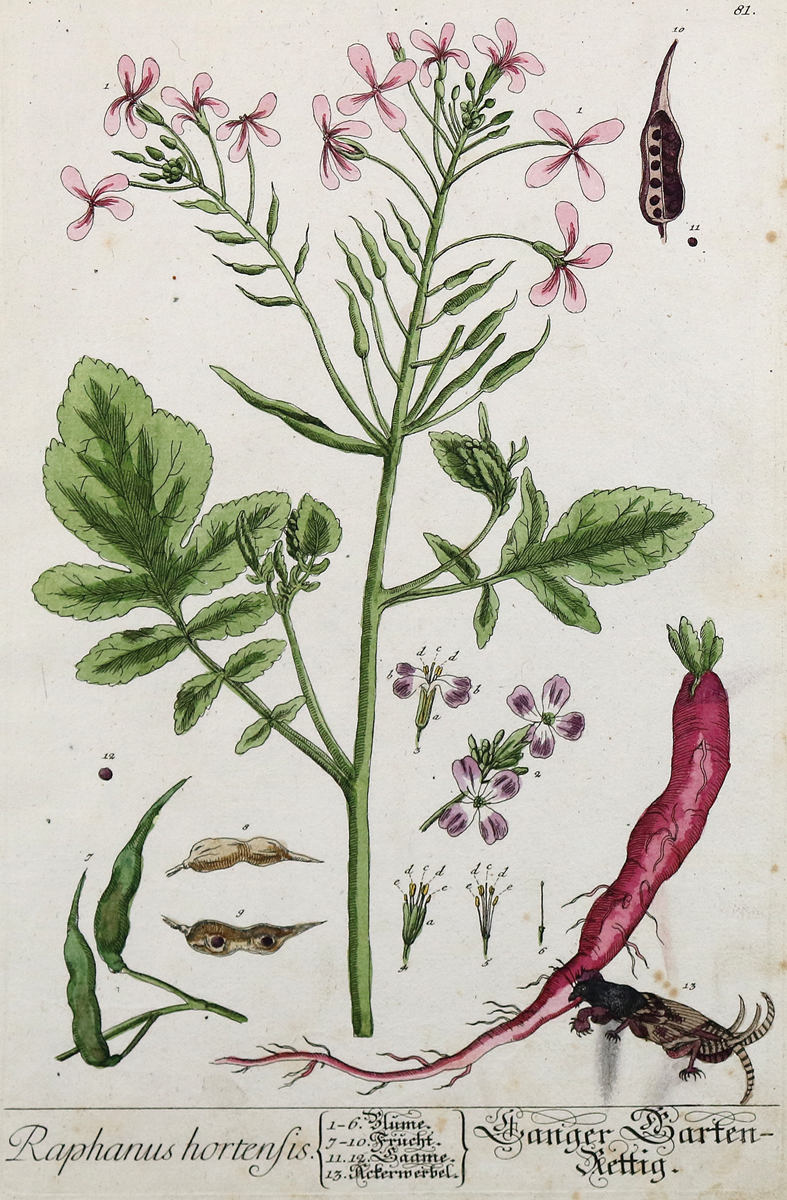BLACKWELL, Elizabeth (c.1700-1758). Herbarium Blackwellianum emendatum et auctum id est Elisabethae Blackwell Collectio Stirpium quae in Pharmocopoliis ad Medicum usum asservantur. Edited by Christoph Trew [and others]. Nuremberg: Johann Joseph Fleischmann, [vols. II-IV: Christian de Launoy, vol. V: heirs of Christian de Launoy, vol. VI: J.J. Fleischmann], [1747-]1750-1754-1773. 6 volumes, 2° (361 x 227mm). Parallel titles and text in German and Latin. 6 hand-coloured engraved frontispieces, heightened in gold, 615 fine hand-coloured engraved plates, all but the last few by N.F. Eisenberger, many heightened with gum arabic. (A few plates lightly soiled or browned, plate 81 with tear at blank margin, plate 500 with internal tear along crease line, occasional browning of text.) Contemporary German half sheep and speckled boards, spines gilt with morocco lettering-pieces (board edges rubbed). THE EXPANDED GERMAN EDITION of Elizabeth Blackwell's A Curious Herbal , with superb plates by Nikolaus Eisenberger (1707-1773) divided into six 'centuria.' The artist initiated the publication on a subscription basis in the summer of 1747. Christoph Trew (1695-1769) was the inspiration behind the project, writing the substantially expanded text for the first 90 plates; the text was then continued by Georg Rudolph Bohmer (1723-1803) and Ernst Gottlob Bose (1709-1773), both leading botanists from Leipzig, under the editorship of Christian Gottlieb Ludwig (1709-1773), who was himself assisted by F.A.G. Knolle in the production of the text to the final volume. Eisenberger worked exclusively from his own paintings, including just over 100 completely new images, as well as reworked versions of Blackwell's plates with added details of flower parts and fruits. He also worked on the German edition of Catesby's Natural History (Nuremberg: 1750), and was employed again by Trew on his masterpiece, the Hortus Nitidissimus (Nuremberg: 1750-1786). Trew is known to have been very slow in producing the text to accompany Eisenberger's plates and the collation of the first volume particularly is known to be 'vexed' with significant differences between copies. The text of volume I in this copy contains 68 unfoliated leaves in agreement with the Harvard copy, and with the last copy sold by Christie's (March 22 2000, lot 11) though not with the BLNH copy, described in Cleveland, which contains 76 unfoliated leaves. The Wellcome copy also has a variant collation for volume I. Collation differences also appear to have extended to the production of the later volumes, so that it is impossible to define a bibliographically 'ideal' copy. Volume IV of this copy has an extra unsigned leaf inserted between X2 and Y1, headed "Nachricht zu der Acht und dreysichsten Ausgabe des Blackwellischen Kräuterbuchs. Nürnberg den 10. December 1759,' not present in the BLNH copy. Arnold Aboretum p. 86; BLNH I, p. 169; Cleveland 444; Great Flower Books (1990) p. 75; Nissen BBI 169; Pritzel 812; Stafleu and Cowan 546; Wellcome II, p. 174. (6)
BLACKWELL, Elizabeth (c.1700-1758). Herbarium Blackwellianum emendatum et auctum id est Elisabethae Blackwell Collectio Stirpium quae in Pharmocopoliis ad Medicum usum asservantur. Edited by Christoph Trew [and others]. Nuremberg: Johann Joseph Fleischmann, [vols. II-IV: Christian de Launoy, vol. V: heirs of Christian de Launoy, vol. VI: J.J. Fleischmann], [1747-]1750-1754-1773. 6 volumes, 2° (361 x 227mm). Parallel titles and text in German and Latin. 6 hand-coloured engraved frontispieces, heightened in gold, 615 fine hand-coloured engraved plates, all but the last few by N.F. Eisenberger, many heightened with gum arabic. (A few plates lightly soiled or browned, plate 81 with tear at blank margin, plate 500 with internal tear along crease line, occasional browning of text.) Contemporary German half sheep and speckled boards, spines gilt with morocco lettering-pieces (board edges rubbed). THE EXPANDED GERMAN EDITION of Elizabeth Blackwell's A Curious Herbal , with superb plates by Nikolaus Eisenberger (1707-1773) divided into six 'centuria.' The artist initiated the publication on a subscription basis in the summer of 1747. Christoph Trew (1695-1769) was the inspiration behind the project, writing the substantially expanded text for the first 90 plates; the text was then continued by Georg Rudolph Bohmer (1723-1803) and Ernst Gottlob Bose (1709-1773), both leading botanists from Leipzig, under the editorship of Christian Gottlieb Ludwig (1709-1773), who was himself assisted by F.A.G. Knolle in the production of the text to the final volume. Eisenberger worked exclusively from his own paintings, including just over 100 completely new images, as well as reworked versions of Blackwell's plates with added details of flower parts and fruits. He also worked on the German edition of Catesby's Natural History (Nuremberg: 1750), and was employed again by Trew on his masterpiece, the Hortus Nitidissimus (Nuremberg: 1750-1786). Trew is known to have been very slow in producing the text to accompany Eisenberger's plates and the collation of the first volume particularly is known to be 'vexed' with significant differences between copies. The text of volume I in this copy contains 68 unfoliated leaves in agreement with the Harvard copy, and with the last copy sold by Christie's (March 22 2000, lot 11) though not with the BLNH copy, described in Cleveland, which contains 76 unfoliated leaves. The Wellcome copy also has a variant collation for volume I. Collation differences also appear to have extended to the production of the later volumes, so that it is impossible to define a bibliographically 'ideal' copy. Volume IV of this copy has an extra unsigned leaf inserted between X2 and Y1, headed "Nachricht zu der Acht und dreysichsten Ausgabe des Blackwellischen Kräuterbuchs. Nürnberg den 10. December 1759,' not present in the BLNH copy. Arnold Aboretum p. 86; BLNH I, p. 169; Cleveland 444; Great Flower Books (1990) p. 75; Nissen BBI 169; Pritzel 812; Stafleu and Cowan 546; Wellcome II, p. 174. (6)



.jpg?w=400)










Testen Sie LotSearch und seine Premium-Features 7 Tage - ohne Kosten!
Lassen Sie sich automatisch über neue Objekte in kommenden Auktionen benachrichtigen.
Suchauftrag anlegen